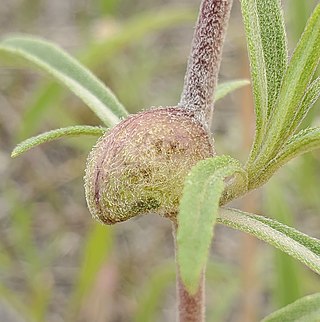
Cecidomyiidae is a family of flies known as gall midges or gall gnats. As the name implies, the larvae of most gall midges feed within plant tissue, creating abnormal plant growths called galls. Cecidomyiidae are very fragile small insects usually only 2–3 mm (0.079–0.118 in) in length; many are less than 1 mm (0.039 in) long. They are characterised by hairy wings, unusual in the order Diptera, and have long antennae. Some Cecidomyiids are also known for the strange phenomenon of paedogenesis in which the larval stage reproduces without maturing first. In some species, the daughter larvae consume the mother, while in others, reproduction occurs later on in the egg or pupa.

The Lasiopteridi is a supertribe of flies from the family Cecidomyiidae. They are often called gall midges or gall gnats.

Asphondylia is a cosmopolitan genus of gall midges in the family Cecidomyiidae. All species in this genus induce galls on plants, especially on flowers and flower buds. There are over 300 described species in Asphondylia, with many more likely to be discovered and described, especially in the southern hemisphere.

Rhopalomyia anthophilathe Downy Flower Gall Midgeis a species of gall midges, insects in the family Cecidomyiidae. It induces galls on the host Solidago altissima across much of North America.
Asphondylia betheli is a species of gall midge in the family Cecidomyiidae. This midge is widespread in the southwestern United States. The larvae of this species induce galls on in the fruit of Opuntia cacti.

Asphondylia helianthiglobulus is a species of gall midge in the family Cecidomyiidae. The larvae of this species induce galls on the stems of several sunflower species in eastern North America, including Helianthus giganteus,H. grosseserratus, and H. maximiliani.

Rabdophaga rigidae, the willow beaked-gall midge, is a species of gall midge in the family Cecidomyiidae. It is found across North America. Some sources state that it is also present in parts of eastern Asia including Japan; however, a 2006 study shows that the Asian populations likely represent a separate species: Rabdophaga salicivora.

Rhopalomyia solidaginis, the goldenrod bunch gall, is a species of gall midges, insects in the family Cecidomyiidae The galls of this species have the following host species of goldenrods:Solidago altissima, Solidago canadensis, Solidago rugosa They have been found across eastern North American.
Cystiphora is a genus of gall midges in the family Cecidomyiidae. There are about seven described species in Cystiphora.
Dasineura parthenocissi is a species of gall midge, insects in the family Cecidomyiidae. It forms galls on Parthenocissus quinquefolia. The gall can host the parasitic wasp Platygaster munita.
Micromyini is a tribe of wood midges, insects in the family Cecidomyiidae. There are about 9 genera and at least 30 described species in Micromyini.

Asphondylia solidaginis is a species of gall midge (Cecidomyiidae) that induces galls on goldenrods in North America where it is widespread. It was first described by William Beutenmuller in 1907.

Rabdophaga strobiloides, the willow pinecone gall midge, is a species of gall midge in the family Cecidomyiidae.
Contarinia virginianiae, known as chokecherry midge or chokecherry gall midge, is a species of gall midges in the family Cecidomyiidae. Its host is the chokecherry Prunus virginiana.

Rabdophaga salicisbrassicoides, known generally as the willow rosette gall midge or willow cabbage gall midge, is a species of gall midges in the family Cecidomyiidae. Their galls and larvae thrive in association with the mutualistic relationship between Formica neoclara and Chaitophorus aphids found on their host species Salix exigua. The larva overwinter in their galls, and adults emerge in late April.

Polystepha pilulae, the oak leaf gall midge, is a species of gall midge in the family Cecidomyiidae. It is found in eastern North America.
Massalongia is a genus of flies in the family Cecidomyiidae. The larvae induce galls on birches.
Asphondylia amaranthi is a species of gall midge in the family Cecidomyiidae.
Asphondylia antennariae is a species of gall midge in the family Cecidomyiidae. The larvae of this species induce galls on the buds of Antennaria plantaginifolia. This species is known from Wisconsin and Maine in the United States, though it's host plant is widespread in eastern North America. It was first described by American entomologist William Morton Wheeler in 1889.

Dasineura folliculi is a species of gall midge that induces galls on several species of goldenrod in North America. It was first described by Ephraim Porter Felt in 1908. Adults live for only one to three days, mating near the goldenrod before laying eggs between leaves. Larvae are gregarious, with anywhere between five and eighty in a gall. The larvae mature within three to four weeks of hatching.











